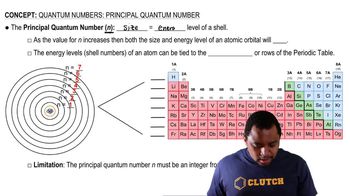Here are the essential concepts you must grasp in order to answer the question correctly.
Atomic Orbitals
Atomic orbitals are regions around the nucleus of an atom where electrons are likely to be found. They are defined by quantum numbers, which describe the energy level, shape, and orientation of the orbital. The 'p' orbitals, for instance, have a specific shape and can hold a maximum of six electrons. Understanding the different types of orbitals is crucial for predicting electron behavior and energy levels.
Recommended video:
Principal Quantum Number (n)
The principal quantum number, denoted as 'n', indicates the main energy level of an electron in an atom. It can take positive integer values (1, 2, 3, ...), with higher values corresponding to orbitals that are, on average, farther from the nucleus. In this context, a 4p orbital (n=4) is at a higher energy level than a 3p orbital (n=3), suggesting that electrons in the 4p orbital are generally located further from the nucleus.
Recommended video:
Electron Shielding
Electron shielding refers to the phenomenon where inner electrons partially block the attractive force of the nucleus on outer electrons. This effect influences the effective nuclear charge experienced by outer electrons, impacting their energy levels and distances from the nucleus. In comparing a 3p and a 4p electron, the 4p electron experiences more shielding from the inner electrons, allowing it to be farther from the nucleus on average.
Recommended video:
 Verified step by step guidance
Verified step by step guidance


